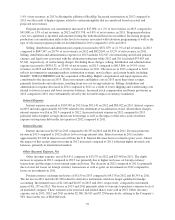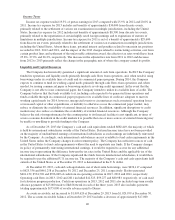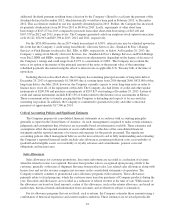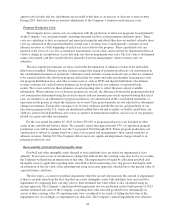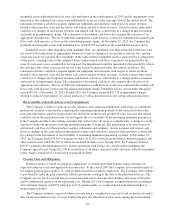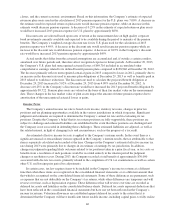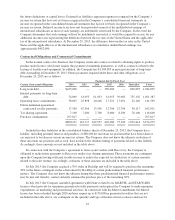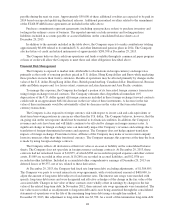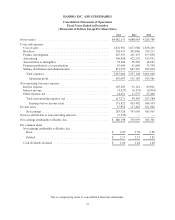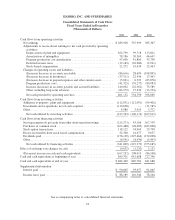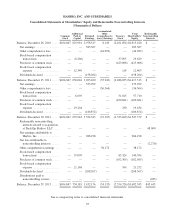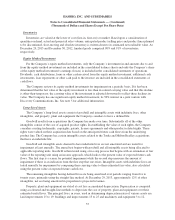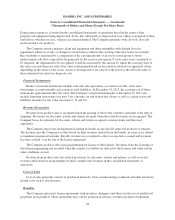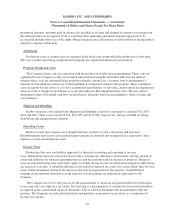Hasbro 2013 Annual Report Download - page 61
Download and view the complete annual report
Please find page 61 of the 2013 Hasbro annual report below. You can navigate through the pages in the report by either clicking on the pages listed below, or by using the keyword search tool below to find specific information within the annual report.
is no longer affected by variable interest rates and, thereby, earnings and cash flows are not expected to be
impacted by changes in interest rates. The Company estimates that a hypothetical quarter percentage point
decrease or increase in interest rates would increase or decrease the fair value of this long-term debt, excluding
the current portion, by approximately $23,000.
Of the $1,384,895 in fixed rate long-term debt at December 29, 2013, $425,000 matures in May 2014. The
Company currently expects to issue long-term notes in 2014 to finance the repayment of most, if not all, of this
debt. As such, during the fourth quarter of 2013 the Company entered into forward-starting interest rate swap
agreements with total notional value of $300,000 to hedge the anticipated underlying U.S. Treasury interest rate
associated with the expected issuance of long-term debt to refinance most, if not all, of the aforementioned
current portion of long-term debt. These interest rate swaps were matched with the expected long-term debt
issuance and are designated and effective as hedges of the change in future interest payments. The fair value of
these instruments is recorded to accumulated other comprehensive earnings and will be amortized through the
consolidated statements of operations using an effective interest rate method once the expected debt issuance
occurs. At December 29, 2013, the fair value of these instruments is $3,172 and is recorded to prepaid expenses
and other current assets.
The Economy and Inflation
The principal market for the Company’s products is the retail sector. Revenues from the Company’s top five
customers, all retailers, accounted for approximately 39% of its consolidated net revenues in 2013 and 42% and
45% of its consolidated net revenues in 2012 and 2011, respectively. The Company monitors the
creditworthiness of its customers and adjusts credit policies and limits as it deems appropriate.
The Company’s revenue pattern continues to show the second half of the year to be more significant to its
overall business for the full year. In 2013, approximately 65% of the Company’s full year net revenues were
recognized in the second half of the year. The Company expects that this concentration will continue. The
concentration of sales in the second half of the year increases the risk of (a) underproduction of popular items,
(b) overproduction of less popular items, and (c) failure to achieve tight and compressed shipping schedules. The
business of the Company is characterized by customer order patterns which vary from year to year largely
because of differences in the degree of consumer acceptance of a product line, product availability, marketing
strategies, inventory levels, policies of retailers and differences in overall economic conditions. Larger retailers
generally maintain lower inventories throughout the year and purchase a greater percentage of product within or
close to the fourth quarter holiday consumer buying season, which includes Christmas.
Quick response inventory management practices being used by retailers result in more orders being placed
for immediate delivery and fewer orders being placed well in advance of shipment. Retailers are timing their
orders so that they are being filled by suppliers closer to the time of purchase by consumers. To the extent that
retailers do not sell as much of their year-end inventory purchases during this holiday selling season as they had
anticipated, their demand for additional product earlier in the following fiscal year may be curtailed, thus
negatively impacting the Company’s future revenues. In addition, the bankruptcy or other lack of success of one
of the Company’s significant retailers could negatively impact the Company’s future revenues.
The effect of inflation on the Company’s operations during 2013 was not significant and the Company will
continue its practice of monitoring costs and adjusting prices, accordingly.
Other Information
The Company is not aware of any material amounts of potential exposure relating to environmental matters
and does not believe its environmental compliance costs or liabilities to be material to its operating results or
financial position.
Item 7A. Quantitative and Qualitative Disclosures About Market Risk.
The information required by this item is included in Item 7 of Part II of this Report and is incorporated
herein by reference.
49


